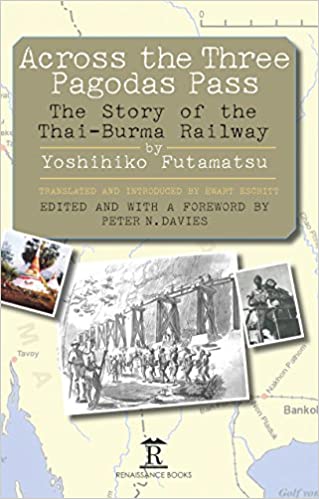The Thai-anusorn obelisk [see Section 14.3] gives us Westerners a glimpse at the way the “other side” viewed this ‘project’. There is an old saying that “the winners write the history”. This could hardly be more true than the dozens of books that have been written by the POWs themselves. Even in those we see a distinct difference in the way the various Allied cultures viewed the ordeal. The British, Australian and American accounts sometimes widely differ. Perhaps because of the language (and cultural) barrier, we know much less about the Japanese perspective on this ‘project’. But thanks to the writings of Yoshihiko Futamatsu (and the translation by English ex-POW Ewart Escritt) we get a glimpse at this ‘other worldly’ aspect. Futamatsu was a professional Engineer not a front-line soldier. In something of an irony as far as the TXNG was concerned, he was even a ‘gunzoku’ or civilian auxiliary soldier; not a member of the regular army. His unit had spent the early part of the war in Malaya, mainly repairing bridges that the Allied forces had destroyed during their retreat. They were then reassigned to build the TBR.
But even as a civilian-soldier, he was ingrained with the basics of the Bushido warrior code. Throughout their lives that Japanese people had been indoctrinated with their place in society and their duty to the Emperor-god they served. We can see this in the accounts of women and children being trained to fight should the Allies have landed troops on the Home Islands. Once they became soldiers, even gunzuko, this devotion to the service of the Emperor-god was even stronger. “Death before surrender” was an aspect of fighting that the Allied soldiers had a hard time reckoning with. For the Japanese soldier this rose to a level of suicidal fanaticism that sometimes culminated in the ‘Ban-zai’ charges. The Bushido warrior’s code held that accomplishment of the assigned mission was part of the serving the Emperor-god. When all else failed, when mission accomplishment was under threat, a Japanese warrior could be induced to charge the enemy even if he was out of ammunition or unarmed having discarded an inoperable weapon.
So even a civilian-auxiliary engineer like Futamatsu had a fanatical devotion to his tasks. His writings tell us so. But we must pause here to draw distinctions between the various groups of ‘the enemy’ that the Allied POWs encountered during their time as prisoners. This applies specifically to those soldiers who was captured on Java and the other DEI islands, but is undoubtedly true of the wider POW experience.
The US POWs were first captured by front-line troops. These men had had no experience or training as to how to treat a POW. The Bushido code simply did not allow for the existence of a soldier who would surrender rather than fight to the death. These troops utilized the POWs as workers in some cases to relieve themselves of burdensome duties. An example of this is related by the HOUSTON survivors who hauled carts of supplies and ammunition replacing the ponies that were intended for that purpose but had been lost (killed?) during the landings. One account says that some of the transport ships that were sunk in the final episode of the history of the USS HOUSTON carried those ponies. So rather than pull the carts themselves, the soldiers used the newly acquired POWs in place of the beasts of burden. For the Bushido warrior, a soldier who surrendered rather than die was not worth any more respect than a beast!
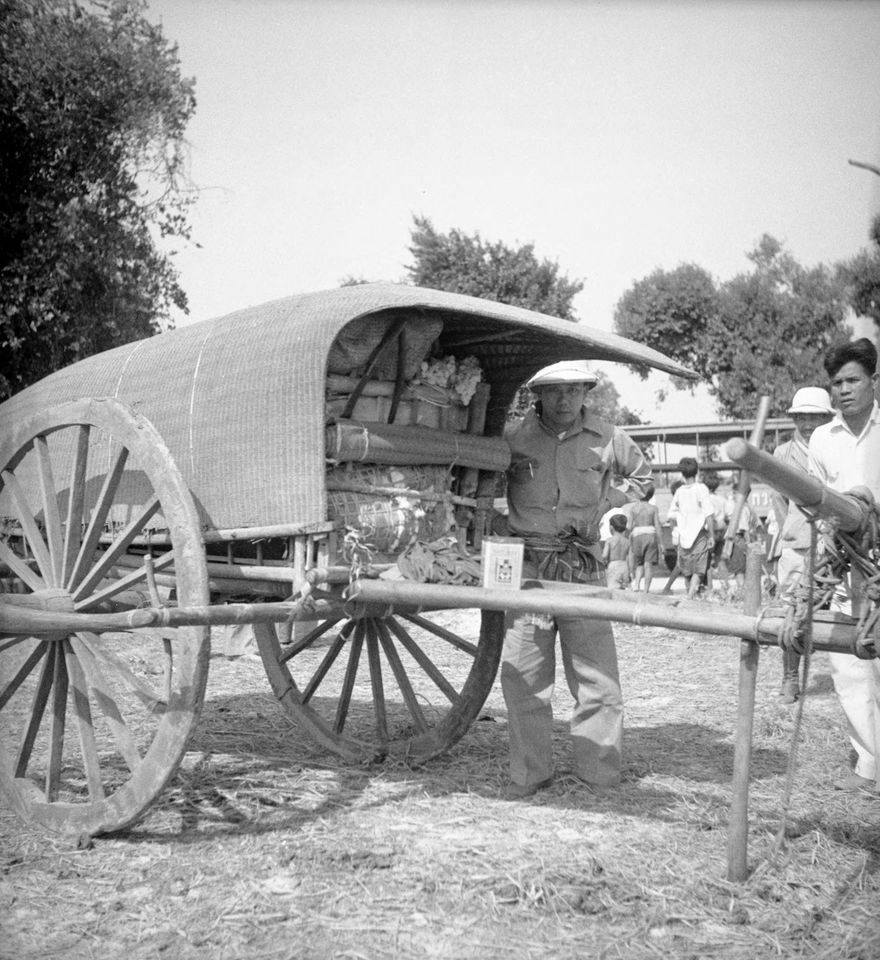
But true to form, these front line soldiers had a mission = to capture the resources of the DEI islands and the Allied POWs were more of a hindrance than a help. So the POWs were most often gathered into ever larger groups and discarded. Most of the US POWs spent time in various places on Java as until the Japanese authorities commandeered the barracks of the Dutch Tenth Bicycle Corps (aka the Bicycle Camp) as the primary prisoner storage area. While they treated the POWs with disdain and continued to use them as laborers, the survivor accounts state that these combat troops were rather distant and benign in their interaction with the POWs.
After a few months into their captivity, while still at the Bicycle Camp, a change of the guards took place and for the rest of their ordeal the Allied POWs were guarded and controlled by designated units consisting of “second tier” Japanese officers and NCOs supervising Korean guards. It is these Koreans and to a lesser extent their Japanese cadre that the POWs describe as the ones who treated them the harshest. The Koreans themselves were in an ‘interesting’ and somewhat awkward position. Their country had also capitulated and essentially became a colony of Japan in 1910. Needing manpower, the Japanese conscripted the Korean men as another type of auxiliary soldier known as ‘heiho’. But they were never considered true ‘warriors’ and the Japanese never trusted nor expected them to fight for the Emperor. Hence, their role as prisoner guards. In the same sense, the Japanese officers and NCOs assigned to this duty were also viewed as lower status than the combat troops and their ‘failings’ were what resulted in the deepest levels of deprivation and humiliation of the Allied POWs. Survivor accounts repeatedly speak of the IJA soldiers in charge of these camps as drunks [1] and psychopaths. Once again, even though these units were specifically formed as prison guards, they apparently received no training what so ever as to the ‘rights’ of POWs. The ever-present Bushido code didn’t allow for POW ’rights’ and asserted the ‘superiority’ of the lowliest ranking Korean soldier over any and all Allied POWs despite their (former) rank.
[1] it is one of the curiosities of this saga that these alcoholics always seemed to have access to alcohol even when the POWs had none of the basic necessities of life. I’d imagine that much of it was ‘locally sourced’.
That brings us to the two other groups of soldiers that the POWs encountered. Futamatsu describes in detail the roughly 5000 troops who made up the actual Railway Engineer units that built the TBR and another 5-6000 troops who supported them. This latter group were administrative, transport, medical and other support (non-combat) troops. The POWs themselves rarely encountered or interacted with these units. With a few notable exceptions, the POWs and the engineers had little direct contact or interaction. For the most part, the engineers set the daily tasks for the POWs to accomplish such as moving a specific amount of earth to build a portion of an embankment. The Korean guards would them drag the ‘kumis’ or work parties out to the site and supervise their work. Once set by the engineers, the ‘mission’ of the guards was to get the POW-laborers to accomplish that task. And they took their ‘mission’ seriously. This is where the ‘bashings’ and other humiliations most often occurred. The overall deprivations – lack of adequate food, shelter, medical supplies – were the result of the inability of the support troops to accomplish their stated mission to support the building of the TBR in as short a time as possible.
So for most of the time they spent as prisoner-laborers, the Allied POWs had constant contact with the Korean heiho guards and lesser contact with the supervisors of those guards and even less with the other Japanese engineers and support personnel. After the war, there were hundreds of Japanese who were tried as war criminals due to the ordeals and deprivation of the POWs. Most of these were the Camp Commandants and cadre, some of the Korean guards, but few were engineers or support troops. John Coast in his account of his time on the TBR points to one of the few engineers that were tried for crimes against the POWs. His name was Teramuto. He was responsible for the two cuttings through the limestone escarpments in the Khao Poon area just outside the ChungKai camp where Coast spent most of his POW time. Coast quotes Teramuto as telling the POWs: “I will teach you to love your tools, or I will kill you.” Then he went on to live that quote! The other place where the engineers played a significant role in mistreating the POWs as at Hellfire Pass. But for the most part, the POWs and the engineers had a rather distant relationship. By contrast British doctor and LtCol ‘Weary’ Dunlop had no use for the engineers and has repeatedly denounced them in his writings.
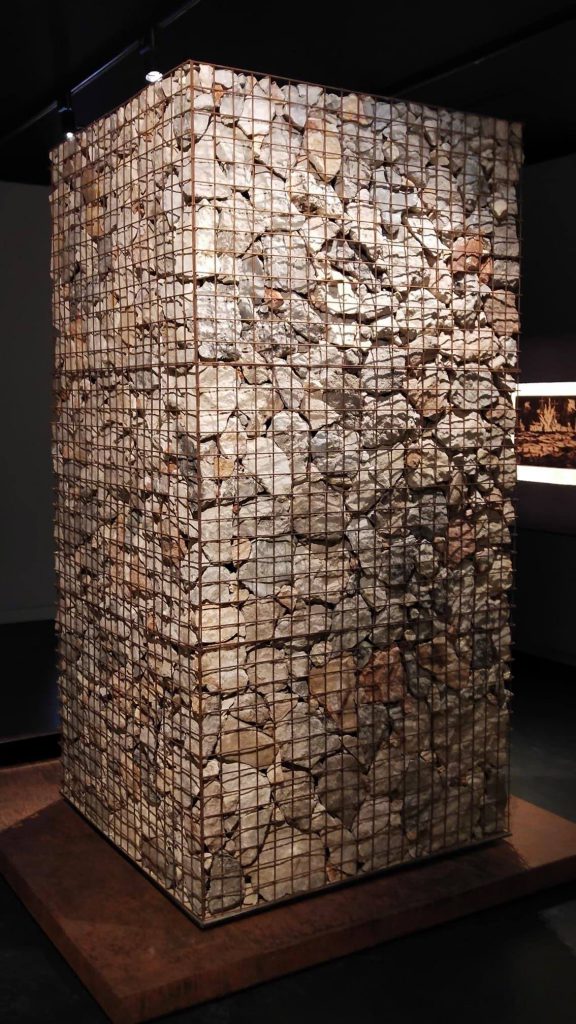
Professor Utasumi is a founding member of a Tokyo-based Research Group on the Thai-Burma Railway and is considered a world expert on the involvement and outcomes of the TBR Korean cadre of guards. His account of the ‘big picture’ places these guards as nearly the same level of victimhood as the POWs themselves. He relates how the Japanese having overrun and essentially colonized Korea in 1910, forcibly ‘assimilated’ the Korean youth into being Japanese. They were forced to adopt Japanese names, learn the language and were indoctrinated in the ways of the Japanese culture at school. Then, as they came of age, they were impressed in the ‘service of the Emperor’ as heiho [military auxiliary] guards. About 3000 of them were sent to the TBR, with thousands of others utilized across SEA. [The youth of the island of Taiwan were similarly impressed and many were sent to Borneo as POW guards as well. There they oversaw some of the infamous atrocities at Sandakan.]
The personal story of one such guard, Yi Hak-Nae [known to the Japanese as Hiromura Kakurai; [McC pg 120-125] is rather typical. He relates that having been ‘volunteered’ to be a heiho, he was provided rudimentary military training but there was nary a mention of POW ‘rights’ or mode of treatment. As was seemingly true throughout the Imperial Japanese Army (IJA), this military ‘training’ included a fair amount of physical abuse which took various forms. The most common was ‘face slapping’ followed by ‘bashings’ = beatings with sticks or even rifles. It was all meant to set solidly in their minds that unwavering obedience was demanded and expected at all times.
Small wonder that slapping, bashing and beating as well as out-right torture of the Allied POWs would follow in steed. The heiho guards were ostensibly paid 50 yen per month and held no noticeable rank in the IJA hierarchy. Again, small wonder that they took out whatever frustrations they had on the only group who held a lower stature: the POWs and to some extent the romusha. Yi was assigned to work at the Hintok area where the well-known Australian physician LtCol E.E. “Weary” Dunlop was the Allied commander of the mainly Australian contingent. Yi was imprisoned briefly at Changi but then released when the case against him proved weak. But en route back to Japan, he was re-arrested in Hong Kong where he learned that the eminent LtCol. Dunlop was one of this accusers. Named as someone who “forced sick prisoners to work”, he was tried, convicted and sentenced to death. After 8 months back at Changi Prison, his sentence was reduced to 25 years imprisonment. Meanwhile a number of his cell-block mates were already executed. In 1951, almost all the remaining war crimes prisoners were handed over to Japanese control and were to continue their sentences in Japanese prisons. Yi was finally paroled in OCT 1956. But under the terms of that parole he was not allowed to return to Korea.
To add to the story of victimization as Professor Utsumi tells the story, Japan had passed law which excluded “non-Japanese” from receiving any services or benefits as ex-War Criminals. Thus, Yi and a 125 or so Koreans like him were dumped into a post-war Japanese economy and culture and were expected to survivor on their own. In the ensuing years, Yi has become an outspoken advocate for reparations to be paid to the surviving heiho guards or their next of kin. That case remains tied up in the Japanese legal system.
Beyond that one tale, Professor Utsumi weaves a saga of the familiar “just following orders” excuse for the actions of the Koreans and to a slightly lesser extent for the IJA NCO cadre who supervised them. He lays no blame what so ever on the officers in charge of the camps or the support troops who utterly failed at their mission to adequately supply the camps with provisions. [Again, it is difficult to dissect post-war revisionist history from any truth that the IJA had any intention of “adequately” feeding, clothing, or treating the Allied POWs medically. Utsumi even offers an argument that ’bashings’ or beating of the POWs was “more merciful” than reporting the infraction of the rules they were accused of to an IJA officer or worse to the dreaded Kempei Tai officials.]
All told, Utsumi recounts that there were 120 cadre of all ranks accused of crimes for acts on the TBR. Sixty-six of the 120 were for direct POW-related crimes and of those 35 were heiho guards; 33 were found guilty, 9 of whom were executed. Only 14 of the 120 were from among the IJA support units on the TBR and 5 from Singapore. His overall conclusion is that the ‘victimized’ 3000 TBR Korean heiho guards bore an unfair burden when it came to direct accusations by POWs against specific individuals. Those who carried out the bashings, beatings and torture (and in a few cases executions) of the POWs were named, but not those who “ordered” these actions. By contrast, reportedly, only 1 TBR engineer was tried and executed as a war criminal. Interestingly enough, that was a Lt Hirota who was also one for whom LtCol. Dunlop held under particular contempt for his actions in the Hintok area. Accusations laid out by LtCol. Dunlop also resulted in the conviction and execution of two IJA camp commanders and an IJA Corporal nick-named ‘Doctor Death’ for his actions while “overseeing” LtCol. Dunlop’s hospital at Hintok. There seems to be some hint of truth in Utsumi’s accusations that many of the TBR convictions were more ‘revengeful’ than they were ‘legally justified’.
Also, per Utsumi, the Allied tribunals who ran these trials out-right refused to accept the “rule of absolute obedience” on the part of the defense of the accused. He does, however, admit (in a scholarly way) that “it is not unreasonable” for the POWs to blame those who actually carried out the abuses. But he continues to contend that those who “ordered” the abuse or in other cases orchestrated the lack of supplies, got off much too lightly – to the point of never having been indicted by name. He also contends that the tribunals simply ignored the total indoctrination in the IJA of ‘absolute obedience’ to one’s superiors. Utsumi sees this as a simple clash between cultures. [Of course, the Germans tried the “just following orders” defense to no avail either!] Utsumi also brings into play a portion of the Potsdam Declaration concerning the terms laid out by the Allied Leaders (FDR, Churchill & Stalin) that in Article 10 states that “All war criminals, including those who ill-treated our prisoners, should be strictly punished.” He suggests that this rather simple statement set the stage for many ‘unfair’ convictions on the flimsiest of evidence. His closing argument on behalf of the victimization of the Koreans (and the Taiwanese) is that the Allies chose to simply ignore the ‘colonization’ and assimilation indoctrination that took place in those two counties as relating [resulting / causing] in any way their actions during the war.
It is hard to tell if it is his post-war revisionist history viewpoint or whether Futamatsu’s narrative was indeed true at the time. He also provides us with a rather benign account of any direct interactions between the engineers and the POWs. He lays out a series of ‘points of contention’ between the professional engineers (many of whom like him were ‘gunzoku’ auxiliary soldiers) and the IJA support troops that were tasked with providing the basic resources for the project; to include food and supplies for the POWs. He contends that from the Railway HQ staff on the Thai side of the TBR on down to the engineers in the field there were constant concerns about the inability of the support units to move sufficient supplies beyond Kanchanaburi. He relates that these units finally relied almost exclusively on barges of varying size to move supplies up as far as the Nam Tok / Hintok area, but there never seemed to be adequate amounts. And that the areas beyond Hintok up to the Three Pagodas Pass suffered inordinately from these failures. He relates a constant flow of complaints from the Field Engineers back to his HQ about the inadequacy of the supplies reaching this forward bases. Of course, the Japanese themselves wanted as much as they could get and always were the first to benefit from a supply delivery, but the complaints (ostensibly]) included the lack of food and medicine for the POWs.
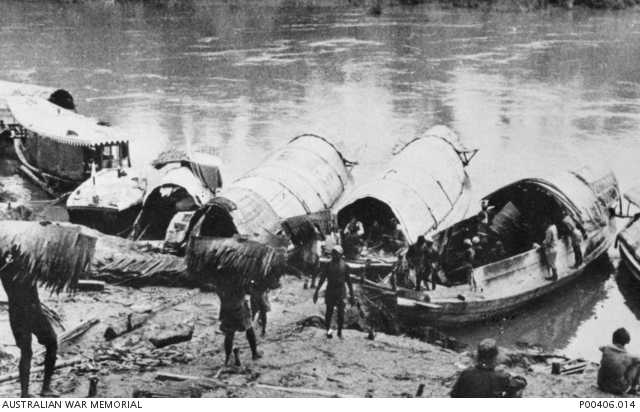
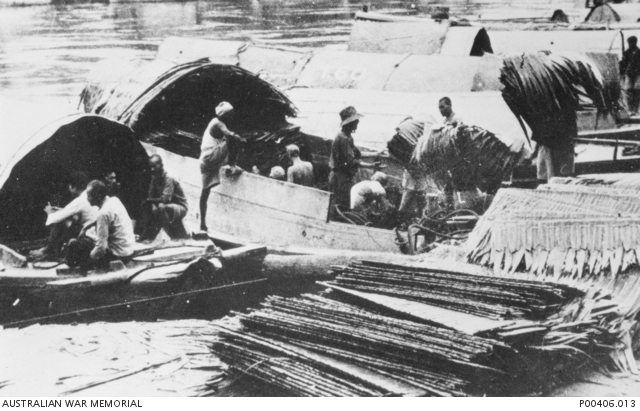
Engineering of the TBR:
Futamatsu provides us with a detailed account of the seriousness with which the assigned engineers undertook the task of building the TBR. As one of the true professional engineers (not men trained by the army), he was assigned to the HQ and oversaw various portions of the railway. He describes in vivid detail his first trip up-country which was done by boat and gave him the first look at the escarpment that would eventually be by-passed by the Wang Po trestle (aka as Arrow Hill or the Tamakachya bridge at Km 102). His destination on that trip was the area of Tarsoa [Nam Tok] / Hintok where the advance survey team was working. These men had been in the jungle for months laying down the actual route meter by meter. The aerial survey photos that the HQ staff had used to generally plan the route had to be made specific by on the ground surveys.
It is generally agreed that the first 50 kilometers at each end of the railway were constructed quickly over generally flat; open terrain. The first major obstacle at the Thai end was the Mae Klong River at Thamakam (the Bridge on the River Kwai). While work proceeded on the bridge, supplies were amassed at Kanchanaburi – a large rail yard was built at Khoa Din just to the south of the walled city. Barges [1] were used to ferry workers and supplies to the far side of the river to continue laying rails while work proceeded on the bridges. Again the 5 Km stretch from KAN to Khao Poom (ChungKai) was flat and straight.
[1] These barges were likely provided by Khun BoonPong; see Section 11.2 for his story.
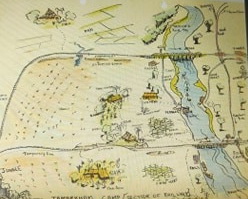
It was at the ChungKai camp that the first real obstacle was encountered in the form of two limestone outcroppings that reached to the shore line of the Kwae Noi River at Khao Poon.
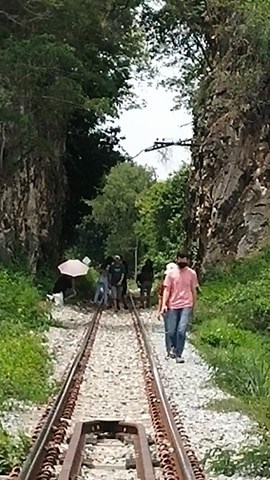
Since there was no practical way around them, they had to be ‘cut’ through [2]. So the first of many ‘cutting’ were chiseled and blasted out of the rock. Once past this obstacle, the route was again rather flat if impeded by denser jungle growth. At WangPo, the massive outcropping required a 400m trestle that clung precariously (and still does today) to the cliff face over the river. Futamatsu remembers seeing this from his boat and immediately beginning to sketch out a platform to circumvent it. To his professional eye, it was nothing more than a challenge.
Some 30 Km later, the pat was again obstructed by the rock that would be cut away to form Hellfire Pass. Although these various trestles and cuttings required serious effort by the POWs and cost many lives, they were not much of a challenge for the engineers. But just beyond Hellfire the terrain began to climb into the mountain-border area. The survey crew struggled to find a path that would allow trains to make the climb. Finally, after much consultation with the HQ, it was decided that a series of switch-backs would be needed. Hence the need for the Three-Tiered and Pack-of-Cards trestles in the Hintok area that provided a rather gentle slope that the trains could negotiate. Once they reached the Sai Yok area and on to Tha Khanun, the terrain was rather accommodating, but soon began to rise to the highest point as it neared the Thai-Burma border. As the rails approached the Three Pagodas Pass Border on both sides was mountainous terrain which required extensive leveling and some additional cuttings. On the Burma side, four major bridges had to be built. When work was going slowly in the Nike (Nikki) area just on the Thai side of the Pass, a portion of H-Force from the Hintok-Hellfire area was sent to reinforce F-Force there. In OCT 43, the two Railway crews met at Konkoita, about 40Km inside the Thai border. Once the ‘copper’ spike was driven, trains began the 412 km journey from Nong Pladuk to Thanbyuzayat.
[2] When asked why they chose ‘cuttings’ rather than tunneling, the Engineers explained that in a tunnel only 4-6 men could work the rock face at one time. Cutting away the rock was much faster since a larger work force could attack it simultaneously.
Locomotive number C5631 had carried the Commanding General and his staff from Nong Pladuk and Kanchanaburi to Konkoita. Later that Engine was transported back to Japan where today it remains enshrined at the Yoshakan museum at the Yoshakuni Shinto Shrine .
https://en.wikipedia.org/wiki/C56_31
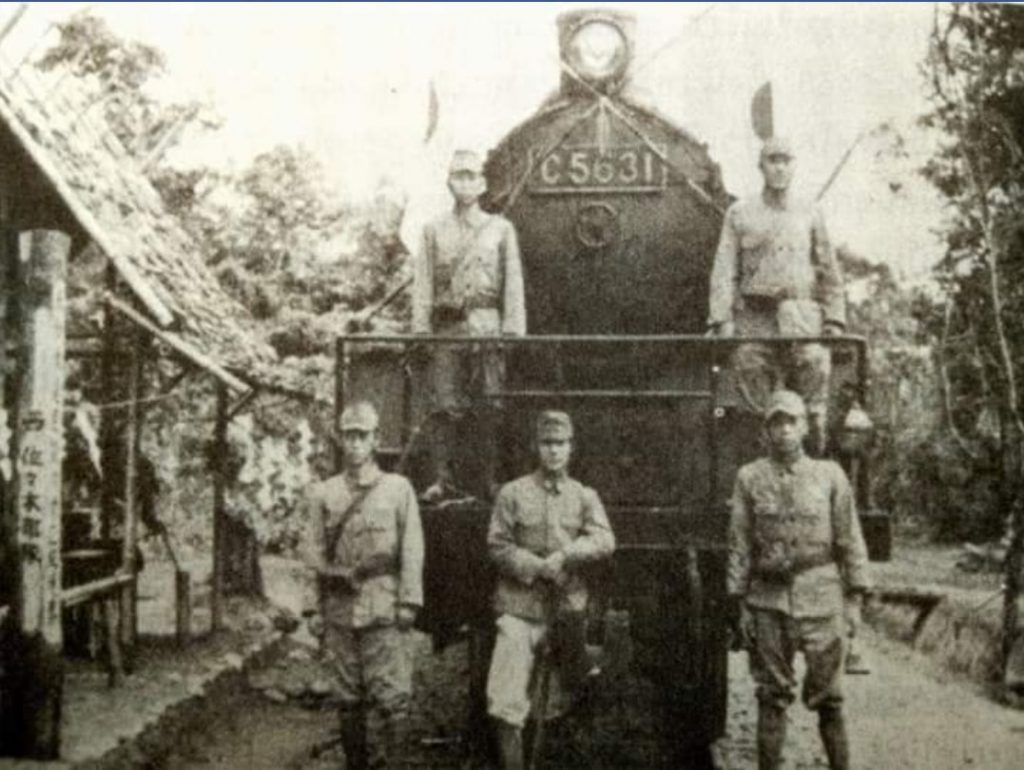
McCormack relates that continuing until the present, survivors of the TBR engineering units meet annually at the Yasukuni Shrine in Tokyo to “celebrate the successful completion of their task” in building the rail line. He goes on to relate that the ‘unfortunate circumstances’ that accompanied the achievement of their goal are seemingly left in the past. The TBR locomotive (#C5631) is the center-piece of that gathering as it stands among many reminders of the war at that shrine.
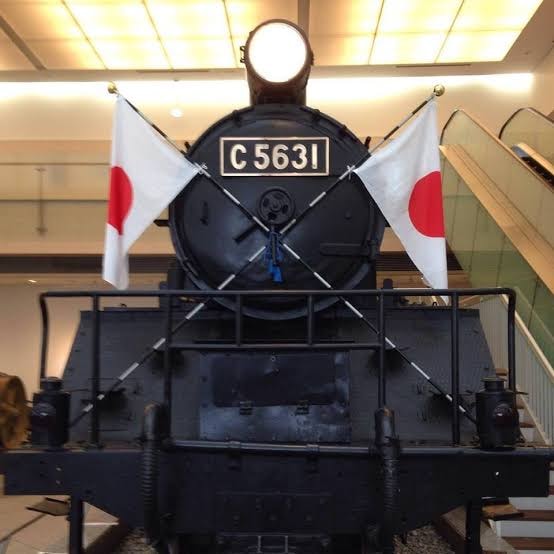
How long it took to build the TBR is reduced to what one determines as the start date. The joining ceremony took place on 25 OCT 43. The Japanese marked the start of the Railway at Nong PlaDuk with a commemorative stone bearing the date 16 SEP 42. But Futamatsu tells us that some Railway engineers were at Ban Pong since about MAR 42 and active surveying on along its proposed path started in JUL. The A-Force arrived in Burma in May 42 and the largely British Group #1 at Ban Pong in JUN. So what date would be the actual ‘start’ date? Why was 16 SEP chosen by the Japanese? Perhaps it was the date of a formal document. Futamatsu tells us that by NOV 42, trains were running between BKK and KAN. But actual ‘construction’ in form of moving dirt and laying rails didn’t start until JUN-JUL at either end of the system. So it took between 16 months (JUN 42-OCT 43) or as little as 13 months (SEP 42-OCT 43), depending on the ‘start date’ chosen.
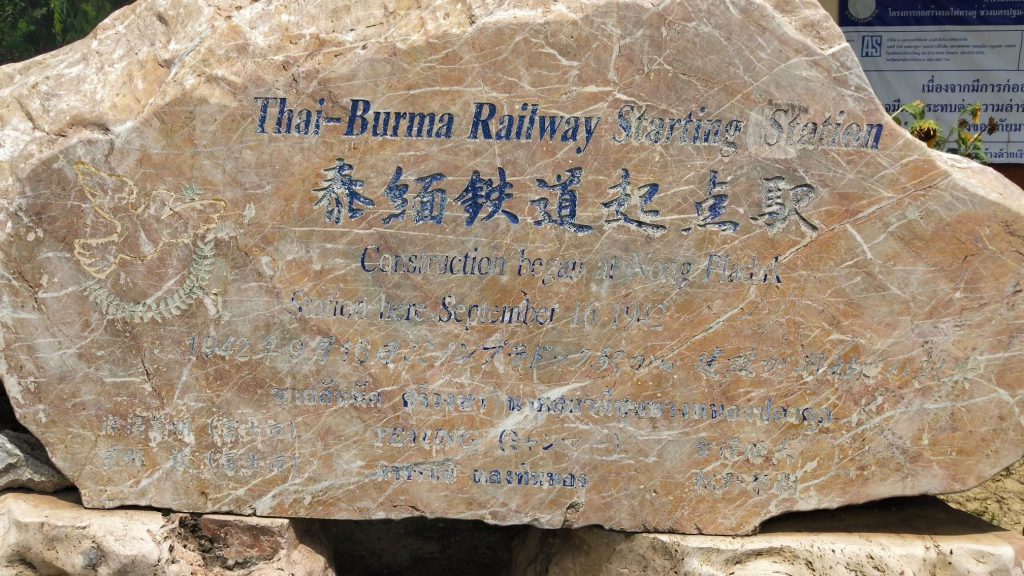
Futamatsu’s narrative of the TBR includes a description of his attendance at the official ceremony held at Konkoita where the locomotive #C5631 was present having carried the Railway Commander from Kanchanaburi. He then launches into a rather detailed summary of the Allied bombing raids on the 4 largest bridges of the TBR, concentrating on #277. He relates how the 2 bridges were damaged multiple times but repairs were always effected within a matter of days. Until finally, in JUN 45 when the central spans of the iron bridge were dropped and the wooden bridge was significantly damaged that traffic on the TBR was halted. The major bridges over the Zami, Winyaw and other rivers in Burma were similarly attacked multiple times.
He adds a lament the many of the returning trains bore sick and wounded IJA soldiers from the Burma Front where the war was turning against them.
He also alludes to the fact that in addition to bombings, there were frequent strafing attacks by fighter planes that targeted anything moving on the rails – including POW work parties. He also (with a different set of figures) speaks to the bombing raid on the Kanchanaburi bridges that killed 94 and wounded 240 Dutch POWs.
Professional Trials and Tribulations of building the railway:
Futamatsu also tells us that from BanPong to the area just beyond Tarsao [Nam Tok] the river was the most efficient and reliable means of transportation and that the meager supplies that reached those camps were mainly carried on barges and small boats operated by Thais who knew the waterway. [see the story of the Thai trader Khun BoonPong in Section 11.2] He also informs us that in the original planning the TBR was to be built with the native ‘romusha’ laborers. But after the fall of Singapore and the DEI, the Japanese found themselves with a huge number of Allied POWs. So many that they struggled to provide them the most meager support in the form of food and personal supplies. It soon became apparent that using the POWs as TBR labor could alleviate two problems = workers and supplies. So in APR 42 the first 3000 Australian POWs (known as A-Force) departed Changi for Burma. They were followed in MAY by another 3000 British bound for BanPong. Various other alphabet-named Forces arrived in suit, until by AUG 43 there were over 47,000 POWs transferred from Changi.
In the early part of 1943, the Engineers in charge of the TBR [Second Railway Division HQ] were worried that they were falling behind the timeline to complete the line by that summer. They promulgated the “Speedo” order which forced the laborers to work longer and harder. Implementation of this order plus the monsoon season resulted in the greatest death toll between MAY and SEP 1943. Late arrivals on the scene were the ill-fated F & H Forces which suffered some of the highest death rates (F) and the worst conditions (H-Force at Hintok). A small group (<30) of US POWs were sent from Singapore as part of H-Force. They worked the TBR a bit farther up the line past the infamous Hellfire cutting. Two forces clashed to make this Speedo period an even greater catastrophe for the POWs: the onset of the monsoon season and its incumbent effect on the flow of supplies. Futamatsu relates that in many of the camps – particularly those beyond Nam Tok — rations were halved for the Japanese cadre and POWs alike due to the inability to delivery supplies. All of these factors conspired to result in the deaths of thousands of POWs (and romusha) from APR – OCT 43. This death toll was exaggerated even more by outbreaks of cholera.
Almost from the time of their arrival at the far end of the line in Thailand near the Three Pagodas Pass, F-Force was hit by cholera carried by the romusha who were already working that area. This largely Australian group had the highest loss rate although their stay in Thailand was quite short compared to some of the other groups. The survivors describe returning to Singapore in railway cars that were no longer packed solid with men since so many had died in the mountains. Australian Capt J.F. Hardacre [McCormack pg18] relates that the death toll in F-force was as high as 60% and even 80% in that portion of H-Force that was moved up the line to augment the work being done at the SongKurai area near the Thai border. McCormack relates that “of the 1600 British troop who marched to SongKurai in May 1943, 1200 were dead by the end of the year.” Cholera alone is credited as claiming 750 of those 1200. It must also be noted that these deaths tolls count only those who died while working the TBR. As F & H Forces were returned to Singapore, many more would die of conditions encountered in Thailand, but they are not generally counted as TBR deaths.
Futamatsu tells us that the number of Japanese involved in the TBR also grew to a maximum of nearly 25,000. [His estimate is the highest on record; most others place in as no more than 15,000.] They were responsible for the care and feeding of about 30,000 British, 18,000 Dutch, 13,000 Australians and 700 US POWs. They failed miserably at that task! The generally accepted figures for deaths by nationality are: 22% of the British, 21% of the Australians, 16% of the Dutch and 18% of the US POWs. These are total figures across the whole of the TBR time. [Compare this to the deaths toll among Allied POWs of the Germans in the European / Mediterranean Theaters which ran 2-4% overall. Although on the Russian Front the figures are much worse.]
However, in that same book relating the overall Australian experience (McCormack APP A pg 160), Hank Nelson places the F-Force death toll at 29% and 25% for H-Force, but that might be a combined figure for H-Force since only a portion moved near the border where F-Force labored throughout their stay. He places the death toll of Australians in Burma as 16% (771/4851) and in Thailand at 21% (1845/8446). The toll in Thailand is blamed largely on the cholera outbreaks in at least two of their camps. While the true number of romusha laborers is unknown (270-300,000), their death toll is estimated to have been as high as 40%!
The high death tolls in the various groups that worked near the Thai-Burma border (Changaraya, SongKurai and Nikki) were seemingly due primarily to two factors: outbreaks of cholera and the difficulty of getting any supplies into that remote and mountainous area far from the Kwae Noi River. Such conditions extended across the border into Burma where the camps farthest from Thanbyuzayat were similarly affected. The borderline at Three Pagodas Pass is shown as 108 Kilometers from Thanbyuzayat and the camps from 80 to 105 on the Burmese side suffered some of the worst conditions and fatality rates. The Tharp party spent much of their time in this area and suffered most of their losses during the Speedo period JUN – OCT 43.
The cholera almost assuredly originated among the romusha laborers and spread down the waterways to the Allied POWs. The same conditions applied in the Nikki and SongKurai areas in Thailand at elevations well above the Kwae Noi River whose size and flow rate seemed to carry the cholera bacteria east. The Hintok area was one of the few that was hit with cholera on the ‘lower’ end of the Thai work area. This is generally blamed on the high number of romusha (especially Tamils) who were in this area building the Pack of Cards Trestle. Per Futamatsu, the vast majority of the romusha (as much as 70%) worked the TBR in Thailand. He also relates that on the whole the Japanese only feared two things: cholera and ‘losing face’ by not completing the rail line in the specified time frame.
He also makes the case that the Japanese cadre (this would include the Korean Guards as a collective group) did not always fare well in this endeavor. He relates his personal experience of making an inspection trip to the advance survey team party of engineers who was laying out the route for the construction crews to follow. He traveled a few days by boat from the HQ at BanPong passing the massive escarpment at Wang Po then the water falls at SaiYok that cascade into the Kwae Noi River. Finally, his group met up with 2Lt Mori and the several NCOs who were performing the actual survey of the route. They had progressed almost to the Tha Khanun area near the village of Tong Pha Phum about 230 Km along the TBR course but still had nearly 70 Km to reach the end of the Thai section for which they were responsible. The border of responsibility between the Thai and Burma commands was actually at Konkoita / Nikki in Thailand not the border line between the two countries at Three Pagodas Pass. But Futamatsu describes the ‘hardships’ being endured by 2Lt Mori’s survey party as living off the land by hunting forest creatures of all types for meat, eating jungle vegetation and enduring the oppressive heat of the dense jungle. All the while they were trying to maintain as direct line as possible to the joining point. That meeting point of the two Regiments would eventually be at Konkoita; 263 Km on the Thai side and 152 on the Burmese.
Per the Hellfire Pass Interpretive Center and Museum, about 1000 Japanese died during the TBR construction period. There are stories of some being killed in rock-falls or, more likely, errant demolition charges while making the various cuttings. Surely diseases like malaria and even dysentery claimed a few, but I have yet to find an accurate accounting of those 1000 deaths. Futamatso doesn’t touch on any of these losses among his comrades. But those losses were most likely among the IJA cadre rather than the engineering units so it is possible he may not even have been fully aware of their circumstances.
Perhaps the greatest loss to the engineers took place on 15 JAN 43, when the Nichimei Maru was sunk en route to Burma. The Tharp party of US POWs was aboard another ship in the small convoy that was attacked by US B-24 bombers. Per their accounts, just about all of the 1500 Japanese in the Railway Regiment on the Nichimei died when the bombs scored direct hits in the forward hold of the ship. The ship sank in under 30 minutes. The Moji Maru carrying US and Dutch POWs stayed in the area to rescue survivors but per the US accounts most of those were Dutch POWs who were in the stern half of the ship. There is one account [http://www.powresearch.jp/en/archive/ship/nichimei.html ] that states that only 100 of the 1500 died, but that is contradicted by the US POWs accounts. That on-line account further states that large amounts of tools and even a locomotive were lost in that sinking.
Certainly, the cadre and engineers that worked the farthest from Kanchanaburi would have had some ‘hardships’ due to the inability to deliver supplies. But it is also undoubtedly true that the cadre would have had ‘first take’ of any supplies that were delivered. So they were likely never more that inconvenienced by a lack of food [1]. Infectious disease like malaria, cholera and dysentery would not have discriminated between POW and cadre. So there were undoubtedly infections and likely even deaths. There were Japanese-run hospitals at Kanchanaburi and there would have been reasonable opportunities for any affected cadre to be evacuated and treated as the supply boats returned. There are also accounts of ’emergency’ deliveries of a cholera vaccine which was administered to some of the POWs as well as the IJA cadre.
[1] There is one account of the cadre resorting to cannibalism in killing a romusha when food ebbed to its lowest. See Section 22.
Many Allied POW accounts denounce the Japanese as a whole for withholding the Red Cross packages that were seemingly delivered to Bangkok and other major ports by ships flagged by neutral countries, primarily Switzerland. Immediately post-war, as the TBR POWs passed through Bangkok, they report warehouses full of these undelivered supplies. At the same time, the POWs accuse the cadre of diverting any such items that found their way onto the TBR for their own use. A few POWs describe receiving one such package for every 8-10 men rather than one per man as they were intended. The US POWs seemed to believe that whatever medical items or drugs that found their way into the hands of the POW medical staff came from these packages. IOW, the Japanese supply system provided none.
One example of a ‘commodity’ that the supply system seemed to be able to provide were comfort women. Sometimes these were taken (forcibly) from the ranks of the romusha but often they were imported from various SEA countries specifically as ‘companionship’ for the cadre.
Futamatsu spends a considerable amount of his narrative detailing the various Japanese Railway units that were responsible for building the TBR. Suffice it to say that the 5th Regiment worked the Burmese side and the 9th in Thailand. He enumerates the number of bridges at a total of 688; most of them quite small spanning streams, canals or gullies that could not otherwise be filled with earth. Of these, 6 are of significant size as to have attracted the attention of the Allied bombers in 1944-45. The latter four of those 6 are in Burma.
- 346.40-metre iron bridge across Kwae Yai River at Tha Makham km. 56
- 90-metre wooden trestle across Songkalia River km. 294
- 56-metre wooden trestle across Mekaza River km. 319
- 75-metre wooden trestle across Zamithi River km. 329
- 50-metre concrete bridge across Apalong River km. 333
- 60-metre wooden trestle across Anakui River km. 369
Two different battalions of engineers were assigned to build each of the two bridges at Thamakam. Futamatsu himself was sent on a quest to find a special dredging tool known as a ‘gatmel’ that was needed to place the concrete footings for the iron bridge. His narrative sets the completion of the wooden bridge at Kanchanaburi as FEB 43 and the iron span as April. [Other accounts set the iron span completion as JUN 43]. All seem to agree that between FEB and JUN 45, these bridges were the target of multiple bombing raids until they were damaged beyond repair in that last raid in JUN. This event effectively brought the entire rail line to a halt. It is also worth re-iteration that no US POWs were involved in the construction of either bridge over the Mea Klong (later renamed the Kwae Yai). Some do report that they worked on repairs and maintenance during their time at the ThaMarKam camp.
End of days:
Futamatsu closes out his narrative of the TBR by describing his own long-awaited repatriation to Japan. It seems that he was in Saigon arranging for the movement of locomotives to the TBR. Because he was not rostered to any Japanese unit in Vietnam, he managed to make his way back to the TBR HQ at Ban Pong. He served time as a POW there, in Bangkok and Nakorn Nayok, before being shipped to Japan. He glosses over any mention of his treatment except to say that work parties were not required. He laments the fact that the movement of Japanese to Japan was delayed due to them having to await transport on Japanese ships; Allied shipping was dedicated to repatriating Allied personnel. He finally reached Japan in JUN 1946.
